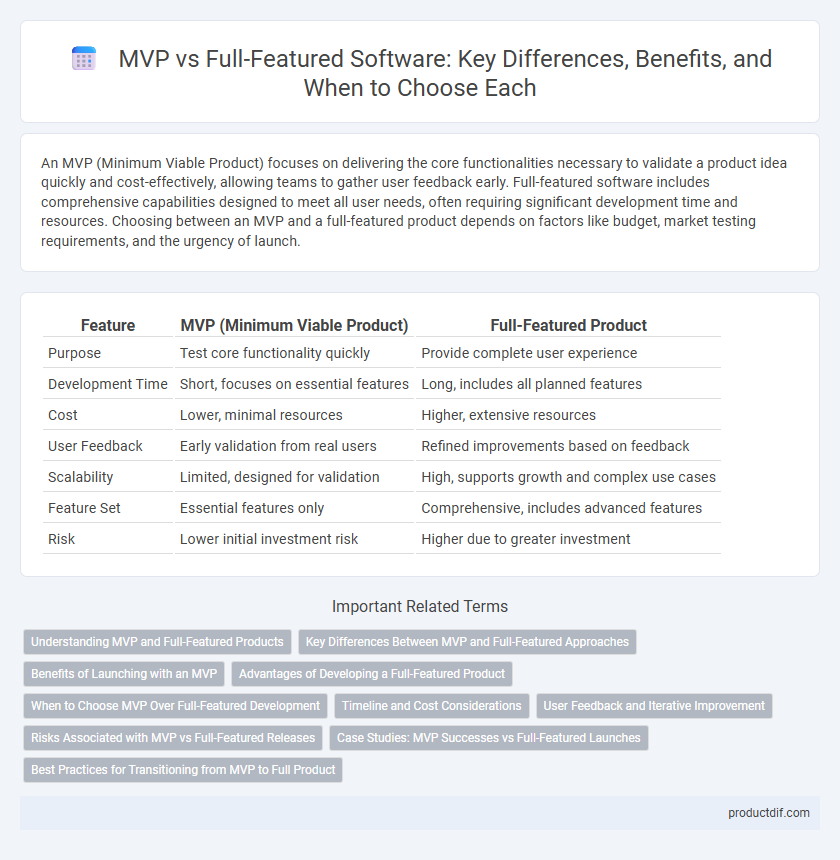An MVP (Minimum Viable Product) focuses on delivering the core functionalities necessary to validate a product idea quickly and cost-effectively, allowing teams to gather user feedback early. Full-featured software includes comprehensive capabilities designed to meet all user needs, often requiring significant development time and resources. Choosing between an MVP and a full-featured product depends on factors like budget, market testing requirements, and the urgency of launch.
Table of Comparison
| Feature | MVP (Minimum Viable Product) | Full-Featured Product |
|---|---|---|
| Purpose | Test core functionality quickly | Provide complete user experience |
| Development Time | Short, focuses on essential features | Long, includes all planned features |
| Cost | Lower, minimal resources | Higher, extensive resources |
| User Feedback | Early validation from real users | Refined improvements based on feedback |
| Scalability | Limited, designed for validation | High, supports growth and complex use cases |
| Feature Set | Essential features only | Comprehensive, includes advanced features |
| Risk | Lower initial investment risk | Higher due to greater investment |
Understanding MVP and Full-Featured Products
A Minimum Viable Product (MVP) is a simplified version of software designed to validate core functionalities and gather user feedback quickly, minimizing development costs and time. Full-featured products encompass comprehensive functionalities and polished interfaces, aiming to deliver a complete user experience and meet broader market demands. Understanding the balance between MVP and full-featured software helps prioritize features, optimize resource allocation, and accelerate product-market fit.
Key Differences Between MVP and Full-Featured Approaches
MVP (Minimum Viable Product) focuses on developing core functionalities to quickly validate product-market fit and gather user feedback, minimizing initial development time and cost. Full-featured software includes comprehensive features and advanced capabilities designed to meet broader user needs and deliver a complete experience. MVP emphasizes iterative improvement based on real user data, while full-featured launches prioritize a polished, ready-for-market product.
Benefits of Launching with an MVP
Launching with a Minimum Viable Product (MVP) enables rapid market entry, reducing development costs and allowing early user feedback to shape product evolution. This approach minimizes financial risk by focusing on core functionalities, ensuring resources are allocated efficiently. Early validation through MVPs enhances product-market fit and accelerates iteration cycles to meet user needs more accurately.
Advantages of Developing a Full-Featured Product
Developing a full-featured product ensures comprehensive functionality that meets diverse user needs, enhancing customer satisfaction and market competitiveness. It allows for robust integration of advanced features such as real-time analytics, security protocols, and customization options, which drive higher user engagement and retention. Investing in a full-fledged solution streamlines future scalability and reduces the need for costly overhauls, ultimately providing a stronger return on investment.
When to Choose MVP Over Full-Featured Development
Choosing MVP development is ideal when validating a startup idea quickly while minimizing costs and risks, allowing early user feedback to guide iterative improvements. MVP focuses on core functionalities essential to solving the primary user problem, enabling faster market entry and reducing development time compared to full-featured solutions. Opting for MVP is strategic in dynamic markets where flexibility and adapting to user needs trump delivering comprehensive, fully polished products upfront.
Timeline and Cost Considerations
MVP development significantly reduces timeline and cost by focusing on core functionalities essential for market testing, enabling faster user feedback and iterative improvements. In contrast, full-featured software requires extensive development time and higher costs due to comprehensive feature integration and thorough testing. Choosing MVP allows startups to validate ideas efficiently, while full-featured builds are suitable for established products targeting scalability and richer user experience.
User Feedback and Iterative Improvement
MVP (Minimum Viable Product) leverages early user feedback to identify core features that address primary pain points, enabling focused development and rapid iteration. Full-featured products often incorporate comprehensive capabilities from the outset but risk slower adaptation due to less initial user-driven refinement. Iterative improvement through MVP strategies enhances product-market fit by continuously evolving based on real user interactions.
Risks Associated with MVP vs Full-Featured Releases
Releasing a Minimum Viable Product (MVP) carries the risk of insufficient user adoption due to limited features, which may impact market validation and brand reputation. Full-featured releases pose higher development costs and prolonged time-to-market, increasing the risk of missed opportunities and higher resource consumption. Effective risk mitigation involves balancing feature scope with iterative feedback to optimize user satisfaction and business outcomes.
Case Studies: MVP Successes vs Full-Featured Launches
Case studies reveal that MVP successes often achieve faster market entry and user feedback integration, enabling iterative improvements that align closely with customer needs. In contrast, full-featured launches tend to experience prolonged development cycles and higher risks of feature bloat, which can delay validation and reduce early user engagement. Data from tech startups show that MVP strategies correlate with increased adaptability and efficient resource allocation during product development.
Best Practices for Transitioning from MVP to Full Product
Effective transition from MVP to full product involves thorough user feedback analysis to prioritize feature development that aligns with market demands. Implementing scalable architecture and modular design best practices ensures seamless integration of new functionalities without compromising performance. Maintaining continuous testing and iterative deployment accelerates quality assurance while adapting to evolving user requirements.
MVP vs Full-Featured Infographic

 productdif.com
productdif.com